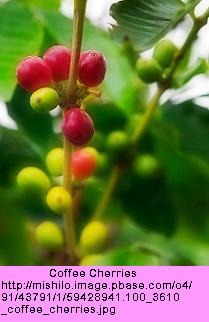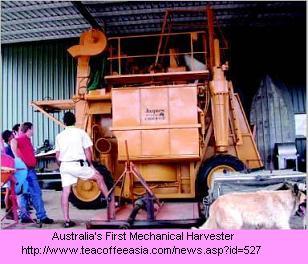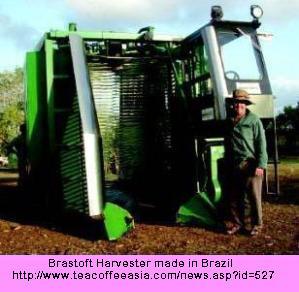
07-0022 Introduction History Current Developments Future Bibliography Acknowledgments About Us |

07-0022 Introduction History Current Developments Future Bibliography Acknowledgments About Us |

 The first attempts at mechanizing coffee harvesting took place in the 1960s
in Hawaii, by using limb shaking techniques which gave a reasonable amount
of ripe cherries but also included a high level of unripe cherries being
harvested. In order for mechanical harvesting to be profitable, the
coffee plants needed to flower and bear cherries at the same time.
This was accomplished with the development of the drip irrigation system.
The first successful mechanized coffee harvester called the FMC-COCO coffee
harvester was built in Brazil in the 1970s. This was a very large
“over-the-row” machine which harvested ripe and dried cherries in one pass.
The first attempts at mechanizing coffee harvesting took place in the 1960s
in Hawaii, by using limb shaking techniques which gave a reasonable amount
of ripe cherries but also included a high level of unripe cherries being
harvested. In order for mechanical harvesting to be profitable, the
coffee plants needed to flower and bear cherries at the same time.
This was accomplished with the development of the drip irrigation system.
The first successful mechanized coffee harvester called the FMC-COCO coffee
harvester was built in Brazil in the 1970s. This was a very large
“over-the-row” machine which harvested ripe and dried cherries in one pass.  In
the l980s, these harvesters were improved in Brazil and Australia using
tine shakers.[5] These harvesters
are shaped like an upside down U tractor with large rotating drums equipped
with an array of 200-300 fiberglass tines or “fingers”. A harvester
would have one or two of these cylinders attached on the sides of a “tunnel”.
It is driven over the coffee rows and the shakers knock off the ripe and
overripe coffee cherries onto a conveyor belt that deposits the cherries
into a bin.[4] These harvesters have
three wheels - two on one side and one on the other - which allow the harvester
to make sharp turns at the end of each row of trees. However, 30%
of the cherries picked by this method are green.[1]
A new self propelled harvester was created later. It could operate
three times faster than the traditional models. The new machine was
also more selective in the cherries it picked and it did less damage to
the trees. The early “over the row” machines could replace an estimated
60-80 men, but this machine was even more effective.[5]
In
the l980s, these harvesters were improved in Brazil and Australia using
tine shakers.[5] These harvesters
are shaped like an upside down U tractor with large rotating drums equipped
with an array of 200-300 fiberglass tines or “fingers”. A harvester
would have one or two of these cylinders attached on the sides of a “tunnel”.
It is driven over the coffee rows and the shakers knock off the ripe and
overripe coffee cherries onto a conveyor belt that deposits the cherries
into a bin.[4] These harvesters have
three wheels - two on one side and one on the other - which allow the harvester
to make sharp turns at the end of each row of trees. However, 30%
of the cherries picked by this method are green.[1]
A new self propelled harvester was created later. It could operate
three times faster than the traditional models. The new machine was
also more selective in the cherries it picked and it did less damage to
the trees. The early “over the row” machines could replace an estimated
60-80 men, but this machine was even more effective.[5]
Today's modern coffee farmer uses drip irrigation to distribute the exact amount of water and fertilizer to the plants. This system consists of hoses with punctures made at intervals of three feet or so. Instead of wasting water and fertilizer, this system waters only the plants’ roots, not the weeds, reducing the need for herbicides and reducing human exposure to chemicals. In addition to protecting our ground water system from excessive chemicals, it also ensures that the trees will flower and bear cherries at about the same time, making it more efficient for using mechanical harvesters.
The tractors that trim the trees have a pruner attached that can turn and cut horizontally or vertically. After the harvest, a driver will cut off about two feet off the top and trim the sides to keep the trees short enough for the harvester and to allow sunlight into the trees.[1]
The tractors can
also have a sprayer attached that can spray the fields with pesticides
if the need arises. However, some farmers such as Waialua Coffee
do not spray pesticides and just use biological controls.[1]